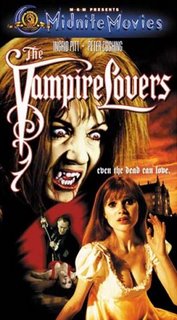
Director: Roy Ward Baker
Release Date: 1970
Contains spoilers
When we looked at the Dracula cycle, and specifically Scars of Dracula, also directed by Roy Ward Baker in 1970, I pointed out that Hammer increased the sexual aspects and gore levels of their films to compete with the burgeoning Euro-horror scene. In the Dracula movie I explained that Baker included a spicing up of the sexual themes and added a high level of gore, in this, however, the gore is apparent, though actually used very sparingly, but it is the sexual aspects that have been really ramped up with definite lesbian overtones and a vast array of naked flesh.
This film is the first of the Carmilla cycle and these took their source from Sheridan Le Fanu’s Carmilla. With the thinly veiled lesbianism contained within the source story, Hammer were able to create a short (3 film) cycle aimed towards a much more adult audience. The Vampire Lovers is, surprisingly, very close to the source story and is probably one of the best adaptations of Carmilla, it does stray but it adds to, rather than takes away from, the story.
The film opens with a scene, partially from the book, of Baron Von Hartog (Douglas Wilmer) taking revenge for the murder of his sister. She had been killed by one of the Karnsteins, an evil family when alive and more evil when dead. He explains that vampires sometimes court their victims taking pleasure in their seduction and slow destruction and at other times they glut upon them immediately. As he watches from within the ruins of Karnstein castle a shrouded figure appears from a grave. The figure floats off leaving behind the burial shroud and Von Hartog explains that they must return to their graves to rest but cannot rest without their shroud. The figure floats into the town and then, from inside the inn, a scream is heard. The door is opened and a dead man with blooded neck falls in.
The figure returns but the shroud has gone and Von Hartog uses it to lure the vampire to him. 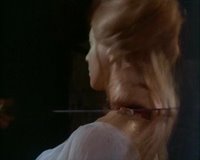 As the vampire approaches he explains that only a stake through the heart or decapitation will kill a vampire. When she is before him it is apparent that she is a pretty girl (Kirsten Lindholm). He seems unable to move and she comes to him seductively but, as she leans in, her bosom touches the cross he is wearing. She jumps back an unfortunately fairly comedic look of horror across her face and he is spurred into action, gripping her hair he decapitates her. This is slightly out with the book; the vampire dealt with by the Moravian vampire hunter is male, it is relayed as a second-hand story, the destruction of the vampire is (if anything) more gory and the Moravian does not resurface in the tale unlike the Baron Von Hartog.
As the vampire approaches he explains that only a stake through the heart or decapitation will kill a vampire. When she is before him it is apparent that she is a pretty girl (Kirsten Lindholm). He seems unable to move and she comes to him seductively but, as she leans in, her bosom touches the cross he is wearing. She jumps back an unfortunately fairly comedic look of horror across her face and he is spurred into action, gripping her hair he decapitates her. This is slightly out with the book; the vampire dealt with by the Moravian vampire hunter is male, it is relayed as a second-hand story, the destruction of the vampire is (if anything) more gory and the Moravian does not resurface in the tale unlike the Baron Von Hartog.
However, it’s an enthralling opening that has the full, rich Gothic look that Hammer did so well. It cleverly explains the main rules to us and lets us know, with the decapitation, that Hammer are prepare to cross the bounds further than before. The comedic look of horror is a shame in an otherwise flawless opening.
We are in the region of Styria (the setting of the original story) and General Von Speilsdorf (Peter Cushing) is throwing a ball. Two of his guests, Roger Morton (George Cole) and his daughter Emma (Madeline Smith), have to leave but confirm that the General’s daughter Laura (Pippa Steel) will come to stay with them soon. After they have gone two more guests arrive, the Countess (Dawn Addams) and her ‘daughter’ Marcilla (Ingrid Pitt), recent neighbours. All the young men seem fascinated by Marcilla, all except Carl (Jon Finch) who is dancing with Laura. Laura thinks the young woman is staring at him but he recognises that she stares at Laura. A mysterious man arrives (John Forbes-Robertson, who would go on to play Dracula) and speaks to the Countess. The General asks her what is wrong and she explains that a friend is dying. The General offers to take care of her daughter whilst she travels. Forbes-Robertson’s character, credited as the Man in Black, is a constant mystery through the film, obviously either a Karnstein or in their employ he watches all from the distance and appears several times through the movie. It could be argued that his unexplained appearance in the film is annoying but, on the contrary, I liked the mystery of the character.
The next day Marcilla gives Laura a garland of flowers and her actions are suggestively seductive. That night, however, 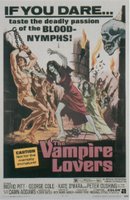 Laura wakes the household with her screams as she awakens from the nightmare of a giant cat choking her. It should be obvious, to the viewer, that Marcilla is a vampire. The transformation to cat is straight from the original story as is the fact that, whilst she dislikes strong sunlight, Marcilla can walk in the daylight. Laura becomes weaker and weaker, her doctor (Ferdy Mayne) suggesting anaemia, and she wishes to see no-one but Marcilla. One night, after a nightmare, Carl is sent to fetch the doctor. Laura is asking for Marcilla but she is not in her room, she appears and explains that she was in the chapel and then, quite calmly, announces that Laura is dead. The doctor arrives and discovers two punctures on the dead girl’s breast and, when they look, Marcilla has vanished. We then see her in the ruins of Karnstein Castle, walking to the tomb of Mircalla Karnstein.
Laura wakes the household with her screams as she awakens from the nightmare of a giant cat choking her. It should be obvious, to the viewer, that Marcilla is a vampire. The transformation to cat is straight from the original story as is the fact that, whilst she dislikes strong sunlight, Marcilla can walk in the daylight. Laura becomes weaker and weaker, her doctor (Ferdy Mayne) suggesting anaemia, and she wishes to see no-one but Marcilla. One night, after a nightmare, Carl is sent to fetch the doctor. Laura is asking for Marcilla but she is not in her room, she appears and explains that she was in the chapel and then, quite calmly, announces that Laura is dead. The doctor arrives and discovers two punctures on the dead girl’s breast and, when they look, Marcilla has vanished. We then see her in the ruins of Karnstein Castle, walking to the tomb of Mircalla Karnstein.
Carl visits the Mortons to tell them of Laura’s death and explains that the Baron has gone to visit an old friend, Baron Von Hertog. We then see Marcilla attack, viciously, a peasant woman in the woods.
Emma and her father are riding when a coach crashes. In it is the Countess travelling with her ‘niece’ Carmilla (the use of anagrams around Carmilla’s name is straight from Le Fanu’s story. From this point I will refer to her as Carmilla). The Countess must get to her brother, she explains, and must be away as quickly as possible. Emma believes Carmilla to be in shock and Morton suggests that she stays with them. The film now concentrates on allowing us to get to know Carmilla and watch her seduction of Emma. Emma begins to have nightmares of a cat choking her. Carmilla, during this courting of her victim, further sates her bloodlust on a woodcutter’s daughter. One problem I found with this scene, as it was a little tacky, was the use of something that sounded suspiciously like the “Psycho” shower scene music, but it is only a small quibble against the generally effective score. When, later, the funeral procession passes the two young women, the priests singing a Latin dirge, Carmilla reacts strongly. She clearly reacts to the hymn and cries that everyone dies – this is directly from the source story.
During this time Morton has to go away on business, leaving the girls in the charge of the Governess, Mademoiselle Perrodot (Kate O’Mara). On his outward journey he bumps into Carl and suggests that he visits Emma, as she is feeling unwell, and mentions she has a friend staying.
One night Emma and Carmilla are talking of her nightmares and she admits that during the dreams the cat transforms into Carmilla and at that point she feels no fear, though it feels as though her life is draining away. It is clear, at this point, by the way Carmilla kisses her that their relationship has blossomed. 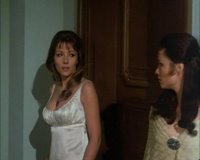 That night Emma wakes the house with a scream, but this time she has punctures on her breast, they had thought that her dreams were the result of a fevered mind but she now has proof of their reality. Carmilla explains to Perrodot that they must be from a broach she gave her and gives the Governess a broach also. Outside Emma’s room Carmilla offers the Perrodot a sultry look and the Governess follows her into her room. Inside Carmilla tells her to turn down the lamp and then, in silhouette, strips.
That night Emma wakes the house with a scream, but this time she has punctures on her breast, they had thought that her dreams were the result of a fevered mind but she now has proof of their reality. Carmilla explains to Perrodot that they must be from a broach she gave her and gives the Governess a broach also. Outside Emma’s room Carmilla offers the Perrodot a sultry look and the Governess follows her into her room. Inside Carmilla tells her to turn down the lamp and then, in silhouette, strips.
In the morning Perrodot is clearly uneasy, tearing her toast rather than eating it. Carl calls and she tells him that Emma is out and that her friend has left. When he pushes she gives him a clear brush off. The butler, Renton (Harvey Hall), tries to get her to call the doctor for Emma but, after looking to Carmilla, she dismisses the notion saying he will be called when she feels it necessary. Later in the inn Renton says that Perrodot is “acting like a bloody vampire.” The inn falls silent and he is told not to joke about such things and also informed of the recent deaths. The penny drops, though he suspects the Governess rather than the friend, and he rushes to see the doctor. Carmilla visits Emma who now believes she is dying and Carmilla, in a very matter of fact way, confirms she is.
The doctor arrives the next day and  states that Morton sent a message that he should visit. Renton is putting garlic flowers into the room and the doctor, having remonstrated that superstition has no place in medicine, suggest he puts more in as they may be medicinal. He also puts a cross around Emma’s neck. It is interesting to note that Perrodot, who wants the garlic removed, also reacts quite strongly to it. On his way home, the doctor is attacked by Carmilla.
states that Morton sent a message that he should visit. Renton is putting garlic flowers into the room and the doctor, having remonstrated that superstition has no place in medicine, suggest he puts more in as they may be medicinal. He also puts a cross around Emma’s neck. It is interesting to note that Perrodot, who wants the garlic removed, also reacts quite strongly to it. On his way home, the doctor is attacked by Carmilla.
Morton returns home and Renton has him speak to the innkeeper (Charles Farrell), who explains to him about the Karnsteins. When Morton looks to dismiss this they say he should talk to the General. The doctor hasn’t arrived, as promised, so Morton rides off to find him. He bumps into Carl and the General who have found the doctor’s body. Having got into the coach he discovers that Von Hertog is with them and they are going to Castle Karnstein. Von Hertog explains that he staked as many of the vampires as he could find, all those years before, but one grave eluded him, he shows them the portrait of the one - Mircalla Karnstein. Morton realises that it is Carmilla and Carl is sent to rescue her as they search for her grave. They find the sarcophagus, but the coffin has been removed. Von Hertog believes that Carmilla will glut herself before returning, he explains that vampires are intelligent and know when the forces of good are arrayed against them so she will want to spend a long time hidden in her coffin.
Meanwhile Carmilla has been trying to have the garlic removed. She eventually asks Renton who warns her of Perrodot. Suddenly she is in his arms, kissing him. Later he walks into Emma’s room and orders the maid to remove the crucifix and garlic. He returns to Carmilla and, after some fumbling, she kills him. Carmilla makes the very weak Emma get out of bed; she is taking her home with her, she says. As they descend the stairs Perrodot begs for Carmilla to take her and, for her trouble is killed. Carl rushes in but Carmilla dashes the sword from his hand. He manages to pull a cross shaped dagger from his boot and ward her back and then throws it at her, but she starts to fade to naught, the blade passing harmlessly through her.
Carmilla returns to the castle and the men hide, they then attempt to follow her but ultimately lose her. Beneath the portrait of Mircalla, 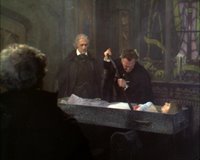 Morton finds her pendant and they lift the stone flag to find her coffin. This is carried to the chapel and opened. As Morton prays that his daughter still lives the General stakes Carmilla (whilst at home Emma cries out “Dear God, no!”), then, lifting her head, he decapitates her. The men then return her coffin to its original resting place as the mysterious man in black watches on. In the final scene we see the portrait of Carmilla turn to a skeleton.
Morton finds her pendant and they lift the stone flag to find her coffin. This is carried to the chapel and opened. As Morton prays that his daughter still lives the General stakes Carmilla (whilst at home Emma cries out “Dear God, no!”), then, lifting her head, he decapitates her. The men then return her coffin to its original resting place as the mysterious man in black watches on. In the final scene we see the portrait of Carmilla turn to a skeleton.
This film oozes atmosphere, both of the traditional Hammer gothic and, in places, of an almost dreamlike quality. As the audience we know what is happening to Emma and yet there is still a palpable tension as we hope that someone will work it out. The interactions between Carmilla and both Perrodot and Renton are Hammer invention, but add a little misdirection to proceedings. Such characters as Carl and Baron Von Hertog are also Hammer inventions.
The cast, as a whole, are very good and Pitt is fantastically seductive as Carmilla, though the innocence she feigns is a little broken by her inherent worldliness. Indeed Pitt controls the screen as much as Carmilla controls the fates of those around her, problematic for feigning innocence but wonderful to watch. Cushing is excellent and, at no time, does his character become confused with his more famous Van Helsing role, which is every credit to the actor’s ability. Perhaps Madeline Smith is just a little too wide eyed and innocent, though that is being really picky.
One common complaint of the Carmilla cycle is the way in which the vampires can walk in daylight. The violent allergy to sunlight is more a 20th Century invention, certainly it was the method used to destroy the vampire in Nosferatu (1922). The 19th Century writers, and I am focusing mainly on Le Fanu and Stoker, had their vampires daylight tolerant. Stoker simply had Dracula’s powers subdued in daylight and, whilst Carmilla would often sleep during the day, Le Fanu also had Carmilla able to walk in the rays of the sun. Kudos to Hammer for actually following the source material here and to those who complain, please bear in mind that the way Carmilla was able to enter sunlight in this film is correct and it is not a problem.
In a way Hammer made a film about Victorian moral standards fighting against open sexuality (especially of a homosexual nature) and allowed the traditional to win in the end and yet used this very openness to titillate the viewer. However, this is a marvellous example of Hammer in action and certainly up there with the best vampire pictures they made – in my opinion. Other than the comedy look of horror I mentioned, at the beginning of the film, and the “Psycho” theme rip-off there really isn’t anything bad I can say about this movie. It just all fits together so well. A definite 9 out of 10.
The imdb page is here.
On Blu-Ray @ Amazon US
On Blu-Ray @ Amazon UK
Sunday, June 11, 2006
The Vampire Lovers - review
Posted by
Taliesin_ttlg
at
1:31 AM
![]()
Labels: Carmilla, cat vampire, undead, vampire
Subscribe to:
Post Comments (Atom)
















12 comments:
Fantastic film! My wife hates this movie and will not allow me to watch it while she's in the house (she's opposed to the naked frolicking) but I constantly insist to her that I enjoy the movie in spite of the ramped-up sexuality, not because of it.
Madeline Smith may be a little overly wide-eyed and innocent, but I've been a fan ever since I've seen her in this movie. Captivating.
Like you mentioned, Ingrid Pitt is just a little too worldly to pull off the feigned innocence, but she does make for a powerful (and sexually charged) vampire.
And, of course, Peter Cushing is great.
The "Carmilla" short story (1872) by J.Sheridan Le Fanu is a wonderful read, too. I have it in a collection of vampire stories, The Penguin Book of Vampire Stories edited by Alan Ryan (1987). It's an excellent collection that I highly recommend to vampire fans. Of course, there's a good chance you've already read it.
Another fine review. Thanks.
Mark, there is a lot more to this than naked frolicking - as you say.
Strangely I do have the penguin book of vampires! lol
Heh heh, I just had a feeling about that.
;-)
Yes, this is the best Carmilla adaptation. It has fantastic atmosphere of elegant Gothic romance.
cheers anonymous
My wife and I enjoyed this movie for the first time on Halloween night. She pointed out how the woodcutter's daughter, I think it was, seems to recognize her killer and welcome her, suggesting some previous tryst. She was taken by the idea Carmilla feels conflicted about falling for, basically, her food. I wondered if she planned to make Emma a vampire. She also thought it was the thought of death to everyone that goads her response to the Latin singing and procession, whereas I took it as the typical aversion to religion on the face of it.
But listen! This blog has been a terrific resource, cross-referenced with Wiki and a couple other sites to educate me on Hammer Films, which I vaguely recall from childhood. I've had plans to insert a character inspired by Carmilla into our own heroic fiction---to create a conflicted, initially amoral character---and after finishing Dracula (and writing it up on integr8dfix.blogspot.com in installments) feel attracted to LeFanu's prose. Well, my salmon in the lake, thanks for the post; I've read this one at least three times.
Hi Cease ill, I'm glad the post and the blog have been of use.
Carmilla is a wonderful story and, when it comes to the prayers, I think both you and your wife are right. Using the story as a source, Carmilla reacts badly to the religous aspect (actually suggesting it isn't her religion) but she also reacts negatively to the thought of death.
In the film, whether Carmilla had persued a previous tryst with the woodcutter's daughter is a mater of conjecture but a nice thought.
Let us know if you pursue your story. Re LeFanu do check out Schalken the Painter :)
The doctor only approved the garlic after noticing that the housekeeper had an aversion to it being there.
I teach the story and the film. With regards to your summary, I would clarify that the doctor sees the garlic as unscientific superstition UNTIL he notices that Peridot does not want it there. Only then does he suggest it could be medicinal.
Fair comment Althair, though it is perhaps a minor distinction it does indeed show that, whilst clinging subconsciously to the scientific (by maintained a quasi-scientific rationale), he was subconsciously reacting to a superstitious level (Peridot's reaction being, of course, supernatural in origin).
Incidentally I have deleted the duplication of your longer comment. The blog is set to authorise comments before they publish – though blogspot is perhaps underwhelming in its communication of that when the comment vanishes and it makes you think it is lost unless you see the little flash message – believe me I have done similar when commenting on other blogs :)
Thanks for stopping by and I hope you’ll spend time exploring the blog and please do leave coments, they are always welcome.
I don't know, in my opinion this film is pretty overrated. It was of course obvious from the beginning that Hammer wouldn't be able to match the subtlety of the original story and, surprise, they couldn't. I'm also not a big fan of Ingrid Pitt who was, in my opinion, miscast as Carmilla. I haven't seen Lust for a vampire, but it seems I haven't missed much, but I actually liked Twins of Evil, maybe because it strayed so much off the source material I didn't mind as much.
And the joy of movies is, of course, that we can disagree 😊
However, it is nice to see a new face here and thanks for commenting
Post a Comment